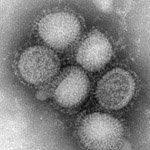The broad fields of Cellular and Developmental Biology are highly interdisciplinary with a presence in all basic medical-science areas, as well as animal and plant biology. Understanding how organisms develop requires a systems-level understanding of how cells achieve different fates, and what combinations of intercellular signaling and intracellular regulatory circuits generate spatially and temporally encoded patterns along the body axis. With the unprecedented expansion of techniques in genomics, molecular biology, and biochemistry, studies in developmental biology require an integrative perspective, applying a "systems" level approach that combines computational and genomic approaches with cell and molecular biology techniques to study developmental phenomena. In particular, many key insights into development are enabled by genetic approaches to understand how genes control the differentiation of cells and the formation of patterns.
Cell Biology

Cell Biology laboratories are investigating the underlying molecular mechanisms of fundamental cellular and organismal processes including the replication, expression, and repair of the genome, transduction of signals from the cell surface to the nucleus in response to diffusible signals or cell-cell interaction, protein trafficking and organellar biogenesis, and protein homeostasis. These laboratories use biochemistry, genetics, structural biology, genomics, high-resolution microscopy, proteomics, and computational approaches, among others, to gain insights into a broad range of fundamental questions.
Developmental Biology

Laboratories that work in this area seek to understand how a multicellular organism arises from a single cell, the fertilized egg. Research in this area spans a broad range of topics, approaches, and experimental systems, including sea urchin development, muscle specification in mice, neural crest development in vertebrates, postembryonic nematode development, Arabidopsis development, mouse T-cell development, Drosophila mesoderm development, Xenopus signaling pathways, stem cell regulatory circuits, genomics and bioinformatics of stem cells, and evolution of development.
Genetics and Genomics

Genetics underlies all of biology and much biological inquiry. We build on our rich history in genetics, in which Caltech geneticists such as Morgan, Beadle, Delbruck, Benzer, Wood, Lewis and Hood laid down the foundations of our understanding of genes, gene function, genetic pathways, and genome sequences. Current research on Genetics at Caltech includes modern developmental and behavioral genetics using flies, worms, mice, yeast, Arabidopsis, and zebrafish to elucidate the genetic control of development, physiology, and behavior.
Research in this area is also supported through the Jacobs Genetics and Genomics Laboratory.
Immunology

The immune system is our defense against pathogenic microorganisms. It involves an innate branch that recognizes generic aspects of pathogens and an adaptive branch that recognizes specific molecules on pathogens. Caltech laboratories are using structural biology, molecular biology, and mouse genetics to study how the immune system develops, how the immune system interacts with microbes that naturally reside in our bodies and are not pathogens, and how signals are transduced in both the innate and adaptive branches of the immune system. In addition, there is a strong translational medicine effort, with a focus on pathologies of the immune system including cancer, engineering antibodies to produce more potent vaccines, and engineering immune cells to attack cancer.
Stem Cell Biology

Laboratories working in the area of stem cell biology are focusing on cell lineage decisions in the early embryo and what drives cells from a pluripotent to more restricted state, eventually leading to differentiation into defined cell types. To achieve these goals, we utilize a variety of approaches including high resolution live imaging, lineage tracing, genomic and epigenomic profiling on the whole embryo and single cell level coupled with perturbation approaches.
Systems Biology

Biological circuits underlie most aspects of cell and organismal biology. Circuit biology seeks to understand "mechanisms," the precise structures and interactions of biological parts—be they genes, cells or organisms—that ultimately produce biological function. Circuit biology often involves computational modeling of potential mechanisms, coupled with quantitative tests of the predictions of models by cell biological, molecular biological, and biophysical techniques.
